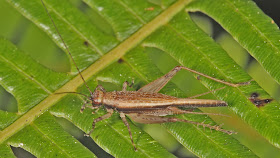Remember to click on the photos to enlarge
Gary Wilson photo
Plants were common in nurseries in the 1970's and the plant was used as a "bank stabiliser" along roadsides and railway embankments.
Gary Wilson photo
Here we see a field of the daisies. They have spread and have overtaken all of the small native plants. A few grasses remain and the ferns along the forest margin seem to survive the onslaught.
Plowing and slashing are useless since the plants spread by surface rhizomes as well as seeds.
You can see the rather slight damage to the plant caused by the feeding of the grasshopper.
This crambid, pyraustine moth, probably Hyalobathra aequalis (Lederer) may be feeding on the pollen and nectar of the flower. As far as known its caterpillars have not been observed feeding on the leaves of the plant.
Small ectobiid cockroaches like this Johnrehnia sp. search for pollen and nectar at night.
Crickets, large and small, do not seem to be affected by dense expanses of the daisies. They take refuge in the tangle of stems at the base of the plants by day and emerge at night to feed on the "rain of particulate" matter the accumulated on the leaves after dark. This is the female of the trigonidiine cricket Amusurgus tinka Otte and Alexander.
This female of the trigonidiine Homoeoxipha lycoides (Walker). It is both diurnal and nocturnal. It normally lives in grasses but seems at home in the patch of Singapore Daisies.
The euscyrtine Euscyrtus (Osus) hemelytrus (Haan) is a widespread diurnal and nocturnal cricket that lives in weedy areas in tropical Asia and Malaysia. It is normally associated with grasses but hides in Singapore daisies.
As far as known there are no programs dealing with the biological control of this weed. Something must be done soon before it gets completely out of control.




+on+S+daisy+5637.jpg)




No comments:
Post a Comment